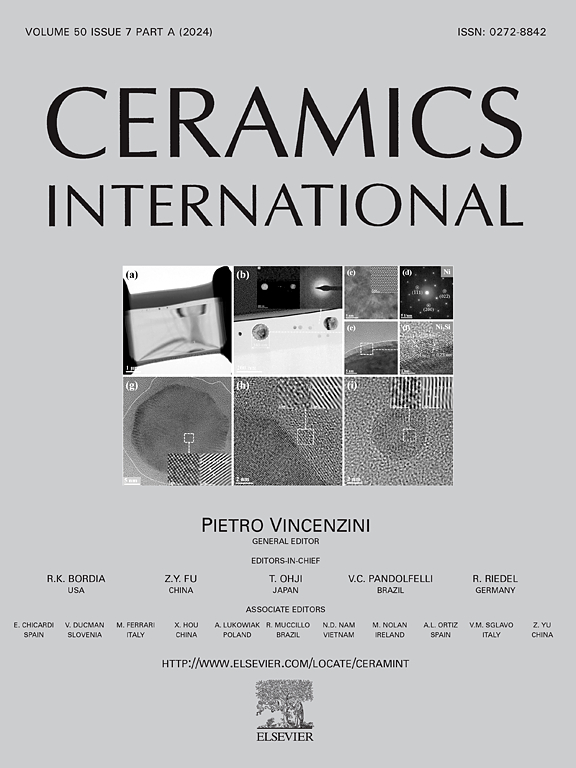Research on the sintering temperature and absorptivity of corundum-based endothermic ceramics for solar thermal power generation
IF 5.6
2区 材料科学
Q1 MATERIALS SCIENCE, CERAMICS
引用次数: 0
Abstract
The absorptivity of endothermic materials serves as a critical index for solar thermal power photothermal conversion systems, and ceramic-based endothermic materials characterized by high absorptivity also exhibit elevated sintering temperatures. In this study, CaF2 was employed as an additive to investigate its effects on the physical properties and microstructure of the samples, with a particular focus on the mechanism by which CaF2 reduces the sintering temperature of corundum-based endothermic ceramics. The results showed that the G2 sample (1 wt% CaF2), sintered at 1650 °C, displayed the best physical properties, including 93 % absorptivity, 165.43 MPa bending strength. The sintering temperature of the CaF2-doped G-series samples was around 60 °C lower due to liquid-phase calcium hexaaluminate formation from CaF2 and Al2O3, which enhanced atomic migration and facilitated ceramic matrix sintering. Additionally, the capillary forces of the liquid-phase calcium hexaaluminate promoted ceramic matrix shrinkage and accelerated corundum-based grain growth through the dissolution-precipitation mechanism, leading to densification. Moreover, the G2 sample exhibited excellent durability, with absorptivity decreasing by only 1.9 % after 100 h at 1000 °C.
太阳能热发电用刚玉基吸热陶瓷的烧结温度和吸收率研究
吸热材料的吸收率是太阳能热发电光热转换系统的关键指标,具有高吸收率的陶瓷吸热材料也表现出较高的烧结温度。本研究采用CaF2作为添加剂,研究了其对样品物理性能和微观结构的影响,重点研究了CaF2降低刚玉基吸热陶瓷烧结温度的机理。结果表明,在1650℃下烧结的G2样品(1 wt% CaF2)具有最佳的物理性能,吸收率为93%,抗弯强度为165.43 MPa。由于CaF2和Al2O3在液相中形成六铝酸钙,使得掺CaF2的g系样品的烧结温度降低了60℃左右,从而增强了原子迁移,促进了陶瓷基体的烧结。此外,液相六铝酸钙的毛细力通过溶解-沉淀机制促进陶瓷基体收缩,加速刚玉基晶粒生长,导致致密化。此外,G2样品表现出优异的耐久性,在1000°C下加热100小时,吸收率仅下降1.9%。
本文章由计算机程序翻译,如有差异,请以英文原文为准。
求助全文
约1分钟内获得全文
求助全文
来源期刊

Ceramics International
工程技术-材料科学:硅酸盐
CiteScore
9.40
自引率
15.40%
发文量
4558
审稿时长
25 days
期刊介绍:
Ceramics International covers the science of advanced ceramic materials. The journal encourages contributions that demonstrate how an understanding of the basic chemical and physical phenomena may direct materials design and stimulate ideas for new or improved processing techniques, in order to obtain materials with desired structural features and properties.
Ceramics International covers oxide and non-oxide ceramics, functional glasses, glass ceramics, amorphous inorganic non-metallic materials (and their combinations with metal and organic materials), in the form of particulates, dense or porous bodies, thin/thick films and laminated, graded and composite structures. Process related topics such as ceramic-ceramic joints or joining ceramics with dissimilar materials, as well as surface finishing and conditioning are also covered. Besides traditional processing techniques, manufacturing routes of interest include innovative procedures benefiting from externally applied stresses, electromagnetic fields and energetic beams, as well as top-down and self-assembly nanotechnology approaches. In addition, the journal welcomes submissions on bio-inspired and bio-enabled materials designs, experimentally validated multi scale modelling and simulation for materials design, and the use of the most advanced chemical and physical characterization techniques of structure, properties and behaviour.
Technologically relevant low-dimensional systems are a particular focus of Ceramics International. These include 0, 1 and 2-D nanomaterials (also covering CNTs, graphene and related materials, and diamond-like carbons), their nanocomposites, as well as nano-hybrids and hierarchical multifunctional nanostructures that might integrate molecular, biological and electronic components.
 求助内容:
求助内容: 应助结果提醒方式:
应助结果提醒方式:


